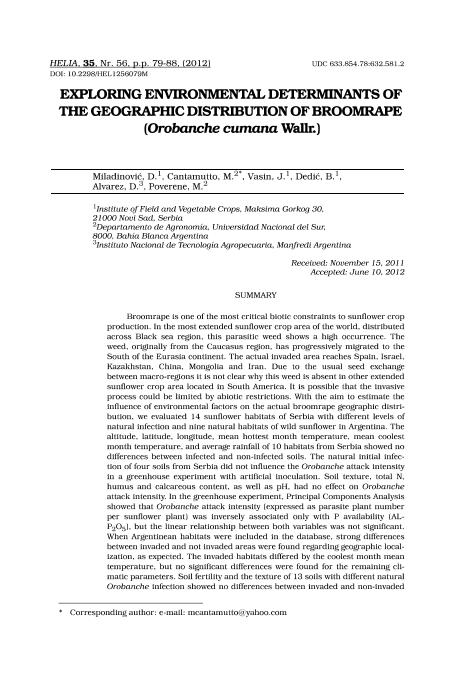Artículo
Exploring the environmental determinants of the geographic distribution of broomrape (Orobanche cumana Wallr.)
Miladinović, D.; Cantamutto, Miguel Ángel; Vasin, J.; Dedić, B.; Alvarez, D.; Poverene, María Mónica

Fecha de publicación:
12/2012
Editorial:
University of Novi Sad
Revista:
Helia
ISSN:
1018-1806
Idioma:
Inglés
Tipo de recurso:
Artículo publicado
Clasificación temática:
Resumen
Broomrape is one of the most critical biotic constraints to sunflower crop production. In the most extended sunflower crop area of the world, distributed across Black sea region, this parasitic weed shows a high occurrence. The weed, originally from the Caucasus region, has progressively migrated to the South of the Eurasia continent. The actual invaded area reaches Spain, Israel, Kazakhstan, China, Mongolia and Iran. Due to the usual seed exchange between macro-regions it is not clear why this weed is absent in other extended sunflower crop area located in South America. It is possible that the invasive process could be limited by abiotic restrictions. With the aim to estimate the influence of environmental factors on the actual broomrape geographic distribution, we evaluated 14 sunflower habitats of Serbia with different levels of natural infection and nine natural habitats of wild sunflower in Argentina. The altitude, latitude, longitude, mean hottest month temperature, mean coolest month temperature, and average rainfall of 10 habitats from Serbia showed no differences between infected and non-infected soils. The natural initial infection of four soils from Serbia did not influence the Orobanche attack intensity in a greenhouse experiment with artificial inoculation. Soil texture, total N, humus and calcareous content, as well as pH, had no effect on Orobanche attack intensity. In the greenhouse experiment, Principal Components Analysis showed that Orobanche attack intensity (expressed as parasite plant number per sunflower plant) was inversely associated only with P availability (ALP2O5), but the linear relationship between both variables was not significant. When Argentinean habitats were included in the database, strong differences between invaded and not invaded areas were found regarding geographic localization, as expected. The invaded habitats differed by the coolest month mean temperature, but no significant differences were found for the remaining climatic parameters. Soil fertility and the texture of 13 soils with different natural Orobanche infection showed no differences between invaded and non-invaded habitats. A better understanding of the abiotic determinants of Orobanche geographic distribution could help to design management tools to prevent the continuous increase of the invaded area and to limit damage to sunflower in the regions presently affected by the weed.
Palabras clave:
Broomrape
,
Climate
,
Geographic Distribution
,
Soil Composition
,
Sunflower
Archivos asociados
Licencia
Identificadores
Colecciones
Articulos(CERZOS)
Articulos de CENTRO REC.NAT.RENOVABLES DE ZONA SEMIARIDA(I)
Articulos de CENTRO REC.NAT.RENOVABLES DE ZONA SEMIARIDA(I)
Citación
Miladinović, D.; Cantamutto, Miguel Ángel; Vasin, J.; Dedić, B.; Alvarez, D.; et al.; Exploring the environmental determinants of the geographic distribution of broomrape (Orobanche cumana Wallr.); University of Novi Sad; Helia; 35; 56; 12-2012; 79-88
Compartir
Altmétricas



